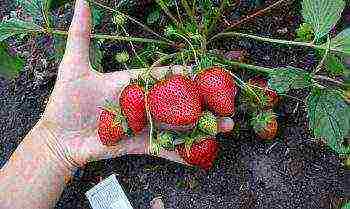Content [show]
Cherry has always occupied an honorable second place after apple among fruit crops. In this article, we will analyze the best cherry varieties for central Russia, as well as a description of trees of early, middle and late ripening.
Types of cherries and features of fruiting
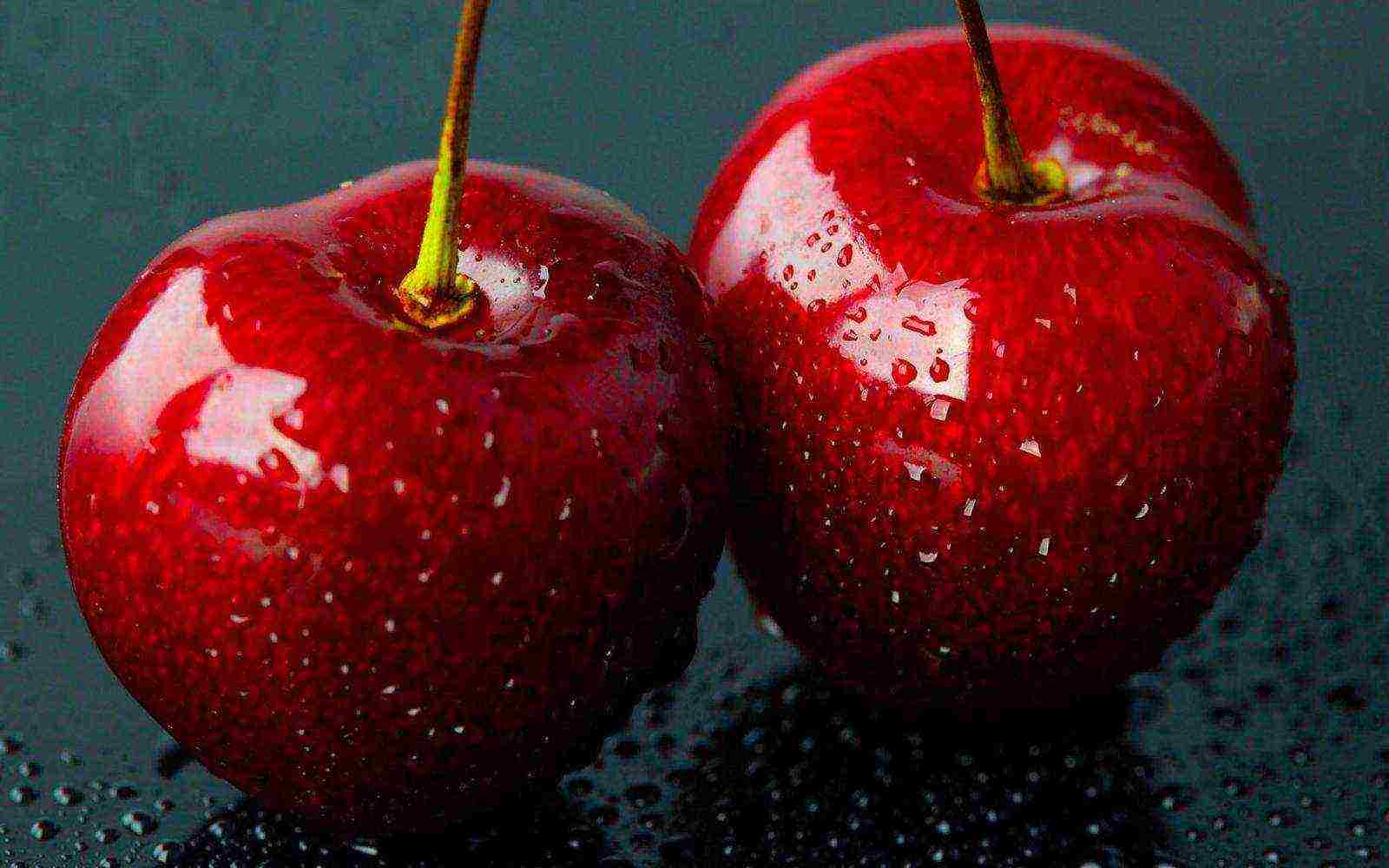
All modern cherries are descendants of sweet and wild cherries. Depending on the prevalence of a particular variety, it depends on what the shrub will be.
Low bush varieties are excellent for the northern strip of the country. They are well covered with snow and due to this they safely tolerate severe frosts. At the same time, many varieties give a large yield. For the southern regions, low-growing tree varieties are suitable, which have a long lifespan (about 25 years).
When choosing cherries, one should take into account that they are self-fertile. Most varieties are self-fertile. This means that they need a pollinator plant. On a private plot, it is better to grow 4-6 trees of different varieties so that they are pollinated and bear fruit regularly.
Popular cherry varieties for central Russia
Choosing the right seedling is not easy. More than one and a half hundred varieties are registered in the State Register. However, not all of them are able to withstand frosts and will yield crops in central Russia.
When buying a cherry seedling, you should pay attention to 4 important criteria:
- yield;
- frost resistance;
- ripening period of berries;
- resistance to various diseases and pests.
Next, we will analyze the best early, middle and late varieties of cherry trees that can be safely grown in the Central European part of the country.
Early
There are very few varieties that ripen at the beginning of summer and have good resistance to severe frosts. But this does not mean that you cannot taste ripe cherries already in June. Early varieties include:
Dessert Morozova
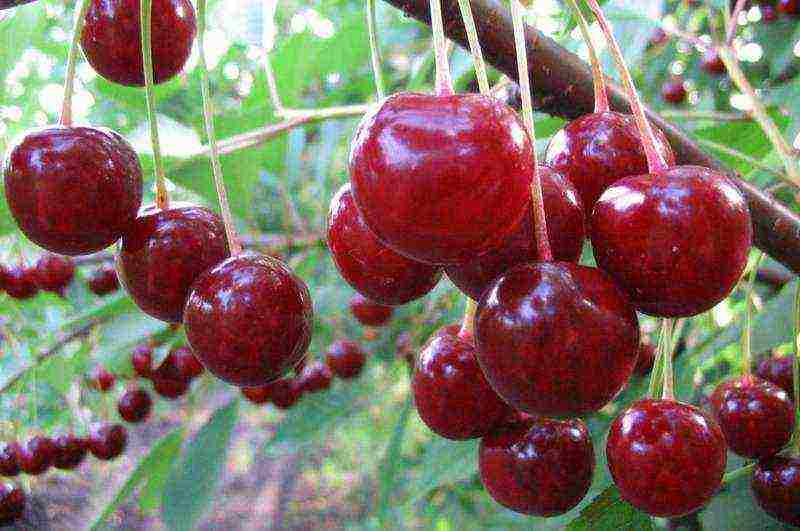
The fruits have a delicate sweet taste with a subtle sourness, medium-sized, round, dense, red. The pulp is juicy. The weight of one berry is 4.5-5 g, the sugar content is 13%. Productivity - 20 kg from one tree. The variety is medium-sized, has a round, medium-leafed crown. Fruiting occurs in the second half of July.
The cultivar is partially pollinated. The best pollinators will be such varieties as Griot Rossoshansky, Griot Ostgeimsky, Vladimirskaya and Studencheskaya.
Annushka
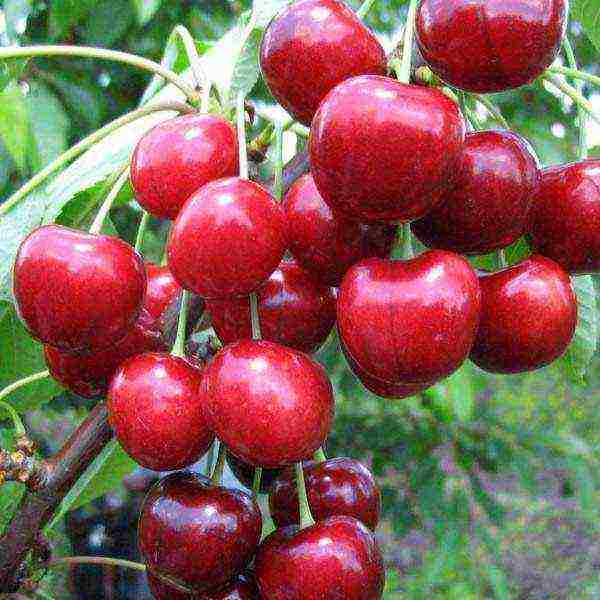
The berries have a pleasant sweet and sour taste, medium size, round shape. Color - from scarlet to dark red. The pulp is juicy and red.The weight of one cherry is 4.8-5 g, the sugar content is 11%. Productivity - 12-14 kg. The tree itself is medium-sized with a very spreading crown, it is winter-hardy. Ripens very early, already in mid-June.
Cherries are self-fertile. Recommended to be planted with various varieties of sweet cherries.
Nezyabka
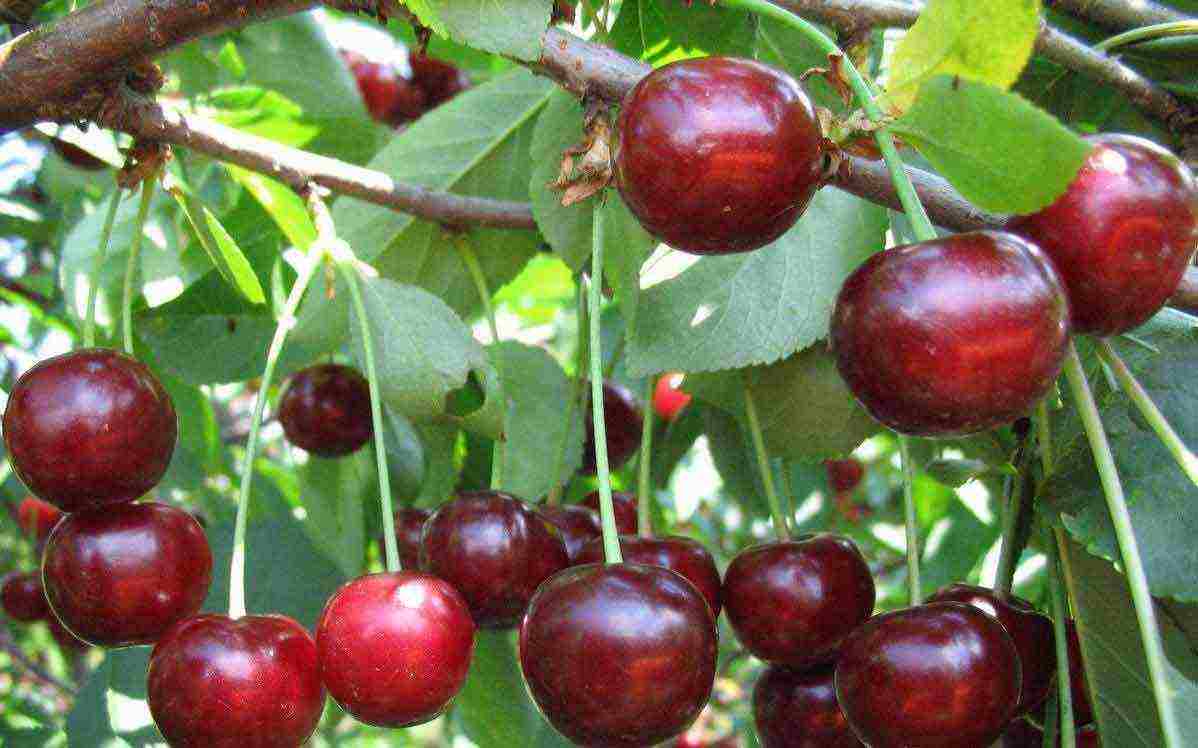
Cherries have a sweet taste with obvious sourness, the fruits are medium, bright red. The pulp is very juicy. The average fruit weight is 4.5 g, sugar content is 10%. The yield is good - 15-20 kg. The tree is tall, it can grow up to 2.5 m. The first harvest gives in the third decade of June.
The variety is self-fertile. The best pollinators will be Mayak, Krasa Tataria, Early Sweet.
Chocolate girl

The berries have a sour taste, the fruits are small, burgundy in color. The pulp is juicy and firm, with an easily detachable bone. Average berry weight - 3.5-4 g. Sugar content - 12%. Productivity - 15-17 kg. A mature tree can reach a height of 2.5 m. The crown has an average density. Begins to bear fruit at the end of June.
As an additional pollinator, it is recommended to plant the varieties Turgenevskaya, Studencheskaya, Lyubskaya and Vladimirskaya nearby.
Spunk

Cherries have a sweet and sour taste, the fruits are small in size, dark red, rounded-flattened. The pulp is juicy, red. Berry weight - 4-5 g. Sugar content - 11%. The yield is very high - 60 kg per tree. The tree itself is very tall, it can reach a height of 6 m. Crohn's have an average density.
The variety is self-fertile. The Shpanki yield is influenced by the Stoykaya and Griot Ostheimsky varieties.
Medium ripening
This is the largest group. Here are presented a huge number of varieties, both new breeding and proven ones with a long history. Many of them are quite popular among gardeners.
Here are the most common ones:
Tamaris
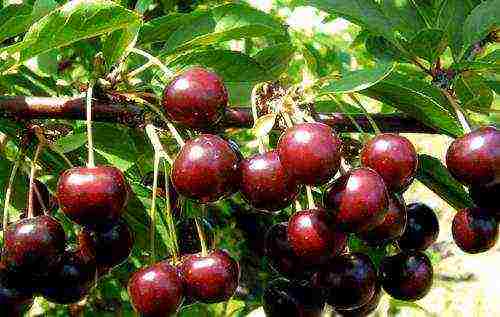
Cherries are sweet with a barely perceptible sourness, rather large, round in shape, the top is slightly flattened, of a dark cherry hue. The pulp is brightly colored, dense, has a delicate texture with a lot of juice. Weight - 3.8-5 g.
Sugar content - 12%. Productivity - up to 20 kg. The variety is low-growing, looks more like a shrub, can reach a height of up to 2 meters. The crown is of medium density and rounded. The first berries can be harvested in early to mid-August.
Tamaris belongs to self-fertile varieties. The average yield increases if pollinators are planted nearby - cherries Zhukovskaya, Turgenevka, Lyubskaya.
Lighthouse
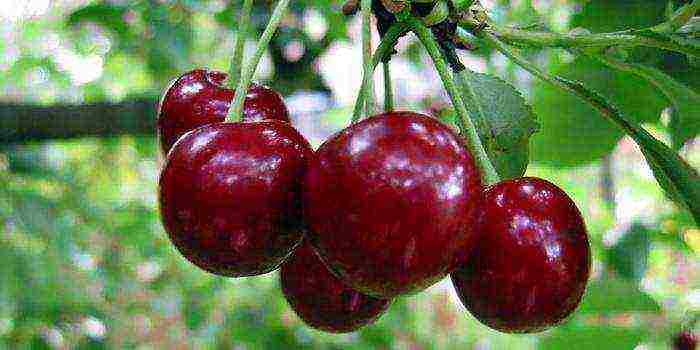
The fruits are pleasant to the taste, very sweet, without sourness, dark red, round, rather large in size. The pulp is fleshy, red and very juicy. Weight is 5-6 g. Sugar content - 14%. The yield is very high - 15-25 kg. The lighthouse is a small spreading bush with an oval crown. Average leafiness. Ripening comes in the second half of July.
The self-fertility of the variety is partial. To get good yields, you need to plant pollinator varieties. For this purpose, Nizhnekamsk, Shakirovskaya, Worker of Tataria are suitable.
Nord-star
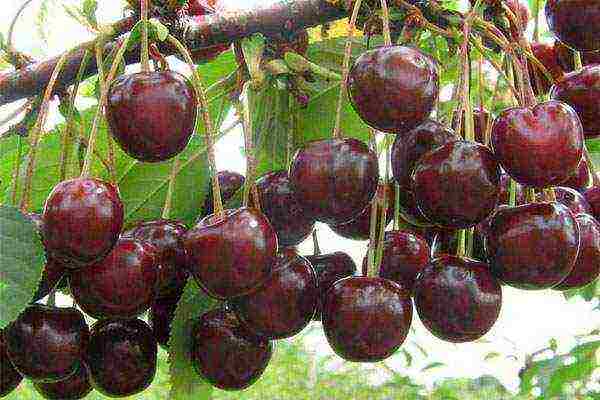
Cherries have a satisfactory sweet and sour taste, wide-rounded, medium and large in size, dark red in color. The pulp is juicy, medium density. Weight - 4-5 g. Sugar content - 9%. Productivity - 15-20 kg. Slightly growing tree with a compact, medium thickened crown. The first crop can be harvested in mid-July.
It is a partially self-pollinated variety. Recommended to plant with Nefris, Meteor, Oblachinskaya cherries.
Vladimirskaya

The fruits are sweet and sour, slightly fibrous, dark red almost black in color, small in size, have a rounded-flattened shape. The pulp is firm and juicy enough. Weight - 2.5-3.5 g. Sugar content - 10%. Productivity - up to 25 kg. The tree has a bushy shape, quite spreading, the branches grow downward. Begins to bear fruit at the end of July.
The best neighbors for Vladimirskaya cherry will be Black consumer goods, Rastunya, Fertile Michurina, Vasilievskaya.
Kharitonovskaya
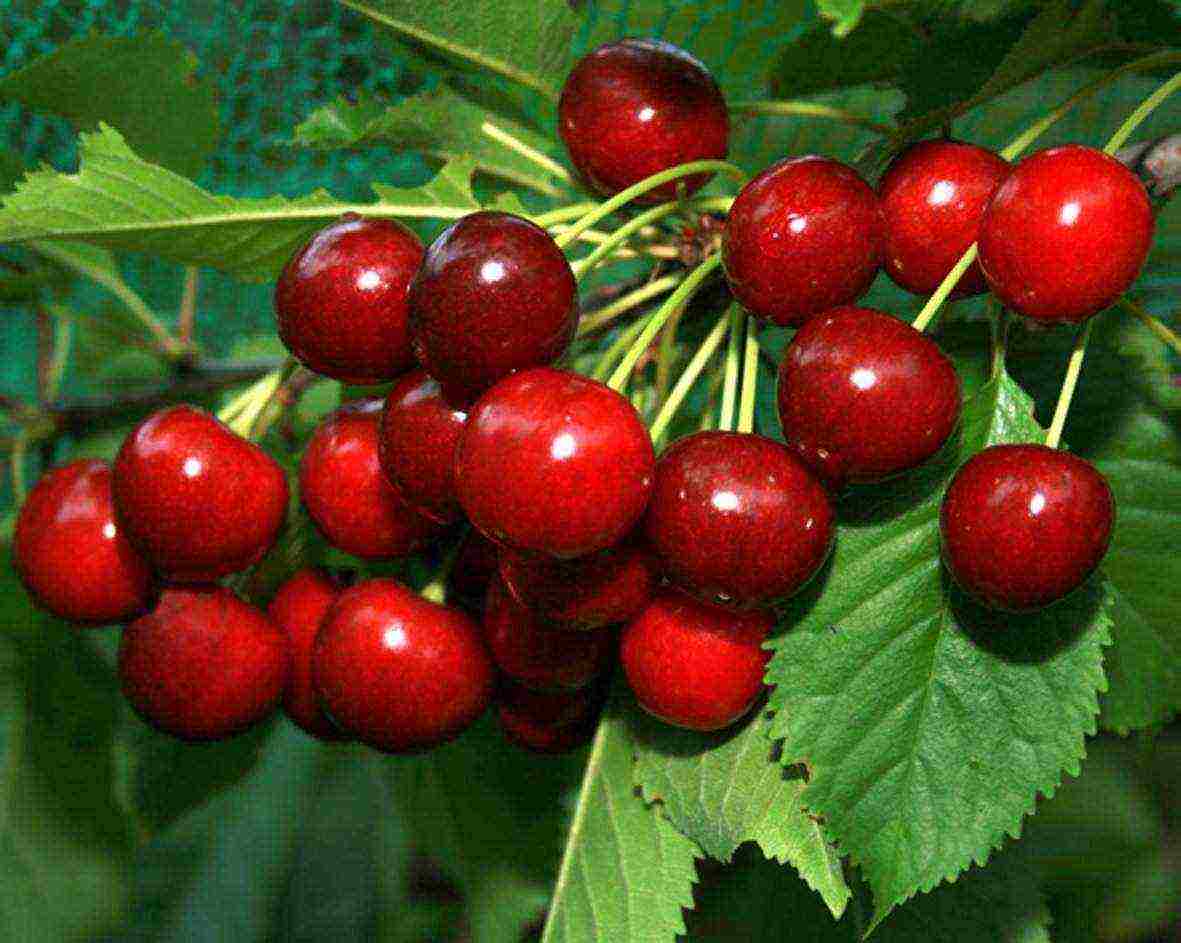
Has a sweet and sour taste, the berries are uniformly rounded, bright red. The pulp is orange, the stone is easily separated, the juice is light red. Weight - 5 g. Sugar content - 11%. Productivity - 20-30 kg. The tree can reach a height of up to 3 meters. It should be noted that this variety grows very much in width.
Needs additional pollination. The varieties Lyubskaya, Zhukovskaya and Vladimirskaya are perfect.
Late
This group attracts with its amazing resistance to frost and berries with an amazing taste. They rarely suffer from cold weather, so they give a very large harvest. Among the late varieties of cherries that are in demand, there are:
Turgenevka
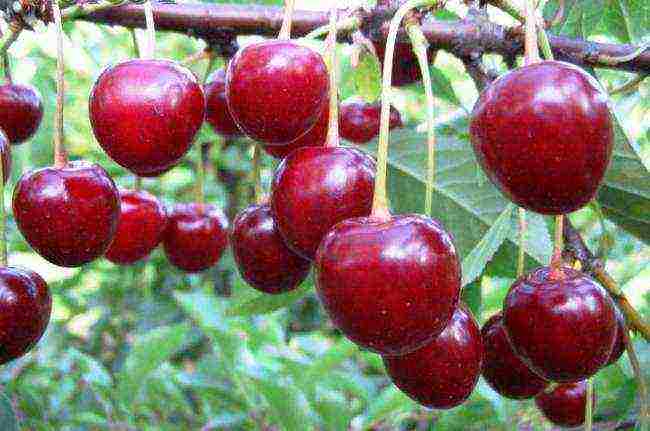
The fruits are sweet, slightly sour, rather large, slightly heart-shaped, have a deep dark red color. The pulp is juicy, brightly colored. Weight - 5 g. The sugar content is 13%. Productivity - 10-25 kg. The tree reaches a height of no more than three meters. The crown looks like an inverted pyramid with not very dense branches.
The Turgenevka variety needs pollinators. The varieties Favorit, Lyubsky, Molodezhny, Melitopol'skaya joy will cope with this task best of all.
Youth

Fruits are sweet, very large, oval, dark burgundy in color. The pulp is brightly colored, contains a large amount of juice. Weight - 5 g. Sugar content - 12%. Average yield - 10-12 kg. The variety is tree-like, undersized with a drooping crown. Ripening begins in the second decade of August.
Self-fertile tree. Morozovka, Turgenevka, Shubinka, Lyubskaya will become good neighbors for him.
Robin

The berries have a pleasant sweet and sour taste, small, rounded, burgundy. The pulp is firm, with dark red juice. Weight - 3-3.5 g. Sugar content - 10%. The yield is high - 40-50 kg. The tree reaches a medium height, the crown is dense and rounded. Ripens late, around early August.
The robin needs additional pollinators. Next to it, the varieties Shubinka, Black Consumer Goods, and Lyubskaya should be planted.
Menzelinskaya
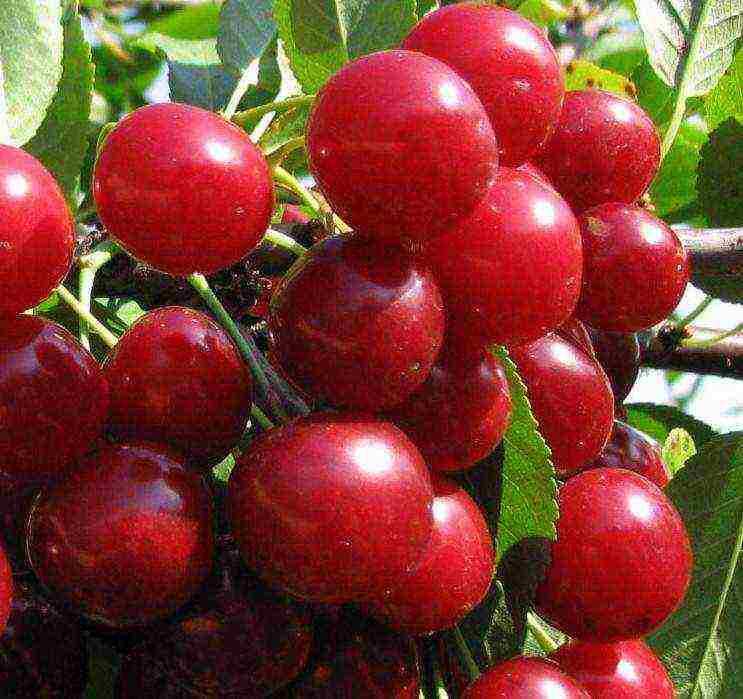
Fruits have a sweet and sour taste, medium in size, red in color. The pulp is firm and juicy. Weight - 4-4.7 g. Sugar content - 9%. Productivity - about 10 kg. The variety is bushy, quite spreading, reaches up to 2.5 m in height, has a weeping crown. The first crop can be harvested in mid-August.
The plant is self-fertile. Vladimirskaya and Shubinka cherries will be good pollinators.
You can grow a beautiful cherry orchard and ensure high yields by choosing the right varieties. Seedlings should be selected based on self-pollination.
All varieties of cherries differ among themselves according to various characteristics, whether it is the ripening time, the size of the fruit or the region of growth. The most frost-resistant cherries are those grown in the northern regions. (Ob, Ashinskaya, Blizzard), but the most productive and sweetest varieties grow in the south of the country (Lyubskaya, Shpanka, Garland). Cherries, early ripening the most stable, but their taste is much more sour (Shokoladnitsa, Molodezhnaya), medium ripening varieties are the golden mean (Vladimirskaya, Zhukovskaya, Turgenevka). Another sign is the presence of flowers of both sexes, that is, self-fertility (Apkhutinskaya, Pamyat Yenikiev). To choose the most suitable cherry variety, you need to know all their characteristics.
Self-fertile varieties of cherries
Self-fertile varieties include cherries that no additional pollination required, and they independently set both male and female flowers.
Apukhtinskaya
A medium-sized tree on which large and tasty heart-shaped fruits grow. The Apukhtinskaya variety begins its fruiting already in the second year after planting, refers to late ripening, the ripening of the crop falls in mid-August.The tree has good resistance to frost and drought, but it is also susceptible to fungal diseases.
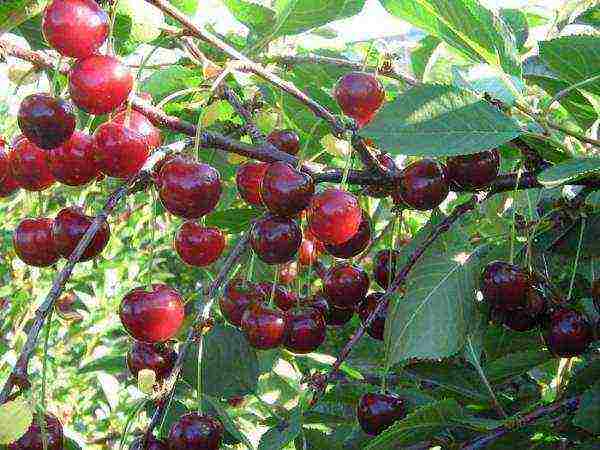 Cherry variety Apukhtinskaya
Cherry variety Apukhtinskaya
Memory of Yenikiev
The tree grows up to 3 meters in height, the crown is of medium density, spherical in shape. Fruit weight reaches 5 gramsso they can be considered large. The shape of the berries is oval, the color is dark red. Cherry pulp Yenikiev's memory is very tasty and juicy. The variety is distinguished by the presence of a large bone... The tree begins to bear fruit already at 3-4 years of age, the period of full ripening of the crop falls at the end of June. Up to 15 kilograms of fruit can be harvested from one cherry.... It has medium resistance to frost and drought.
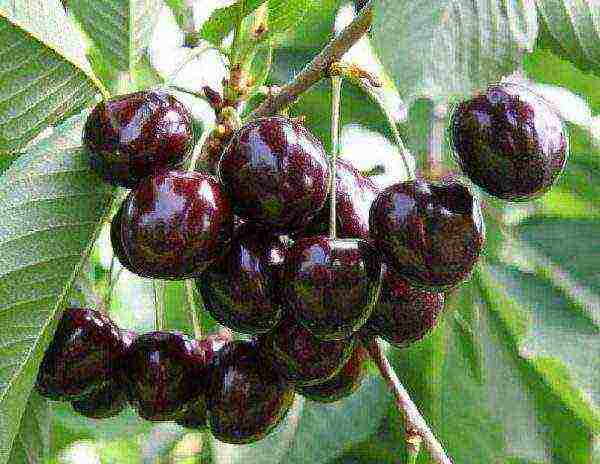 Cherry in Memory of Yenikeev
Cherry in Memory of Yenikeev
Also, self-fertile varieties of cherries include Garland, Brunette, Cinderella, Shokoladnitsa, ErdiBetermo, Ksenia, Nochka, Vstrecha, etc.
Early varieties of cherries
Cherry varieties that ripen between early June and mid-July are called early cherry varieties.... Their berries are less sweet, and the trees have good frost resistance.
Chocolate girl
This cherry tree is of medium height, with a crown shape reminiscent of an inverted cone. The berries are distinguished by their sour taste and maroon color. The pulp is a deep red shade, dense, with an easily detachable bone... The Shokoladnitsa variety tolerates frost and drought well, is resistant to many diseases, and is self-fertile. Brings a stable harvest.
 Cherry Shokoladnitsa
Cherry Shokoladnitsa
Spunk
This variety is a cherry-cherry hybrid. A tall tree with freely growing branches resembles a ball in its shape. In addition, the attachment of branches to the tree is rather weak, so when the crop appears, there is a risk that they will begin to break. The taste of berries is sweet and sour, on average, their weight is 4 grams... Fruit color is dark red, rounded-flattened shape. The first crop of Spanka brings in 6-7 years of life, but at the age of 20 you can get up to 60 kilograms of cherries from a tree. Fruiting occurs from late June to early July... The variety is highly resistant to frost and drought and needs pollinators.
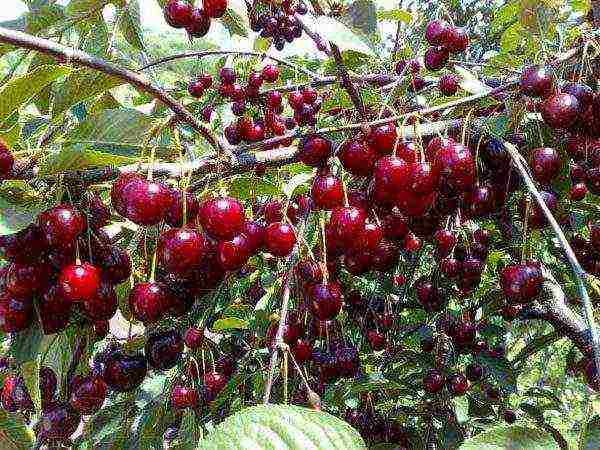 Cherry varieties Shpanka
Cherry varieties Shpanka
Youth
Shrub cherry, with a low, slightly drooping crown. The fruits of the Molodezhnaya variety are large in size, their weight can reach 4.8 grams, the skin and pulp have the same maroon color. The stone separates well, and a slight sourness is felt in the taste of the cherries themselves, such berries are perfect for preservation and freezing. The first crop appears on a 5-year-old tree, fruiting mainly occurs on last year's wood... Molodezhnaya is a frost-resistant variety. Has an average disease resistance.
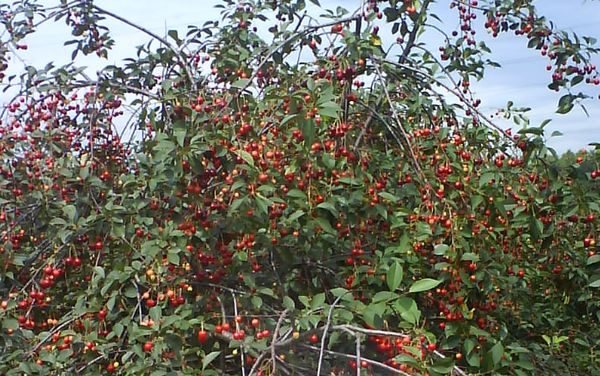 Shrub self-fertile cherry variety Molodezhnaya
Shrub self-fertile cherry variety Molodezhnaya
Miracle cherry
Arboreal cherry with medium vigor. The crown of the tree needs constant formation, with a free form of growth, it looks like a cone, and the fruits will accumulate at the very top. The taste of berries is dessert, sweet, in all their external characteristics they resemble cherries, can reach a weight of 9.5 grams. The variety is self-fertile and needs pollinators. The tree begins to bear fruit from the age of 3 years, while bringing a large, stable harvest. You can harvest the fruits already at the beginning of June. Miracle cherry is resistant to frost and most diseases.
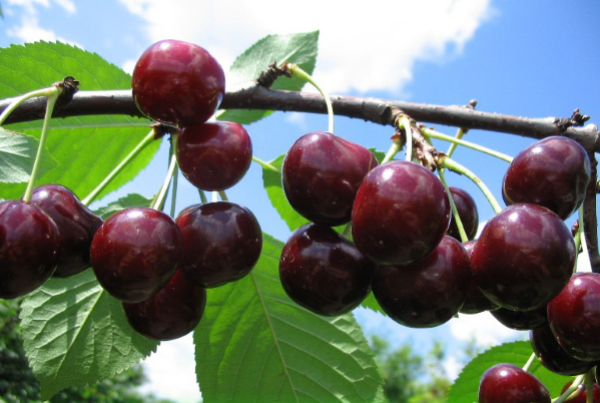 Variety Miracle cherry
Variety Miracle cherry
Baby
The tree is of medium height and spherical in shape. It bears beautiful dark red fruits with a pleasant sweet and sour taste, the stone is easily separated from the pulp. The shape of the berries is round, evenly flattened, the weight reaches 5 grams... Variety Malyshka Differs in good transportability, immunity to fungal diseases and frost resistance. Productivity is inferior to other varieties, from one tree you can get 17 kilograms of cherries. Their full maturity falls at the end of June.
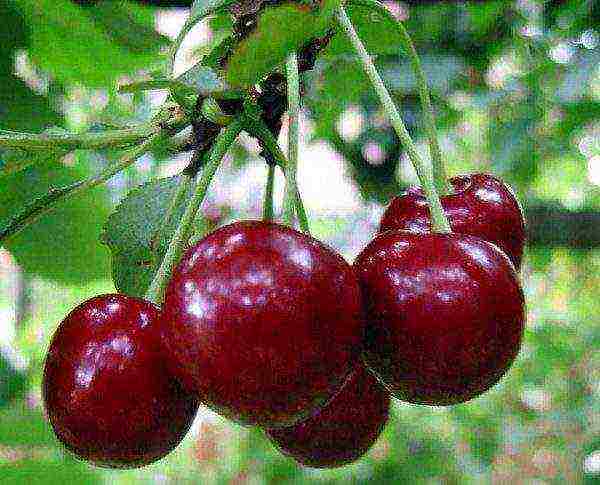 Cherry variety Baby
Cherry variety Baby
There are also other early ripening varieties of cherries.For example, Memory, Bulatnikovskaya, Enikeeva, Bagryanka, Sania, Vasilievskaya.
Medium ripening cherry varieties
Middle-early cherries are called cherries that ripen in the middle of summer, they have the best taste.
Vladimirskaya
 Cherry fruits Vladimirskaya
Cherry fruits Vladimirskaya
Vladimirskaya - one of the oldest varieties grown in the central regions of Russia. Bushy tree, grayish bark... The branches grow downward, so the shape of the crown is called weeping. 5-7 flowers of delicate white color are collected on one inflorescence. Leaves of a matte green shade, elongated, gradually sharpening towards the base and apex, the edge is double-serrate. Fruits are sweet and sour, slightly fibrous, well suited for all forms of processing. The color of the skin is dark red, almost black, the weight of the berries does not exceed 3.7 grams, the shape is round-flattened. The first fruiting occurs in the 3rd year of life., cherry ripening occurs at the end of July. This variety tolerates winter cold well, but spring frosts can completely destroy the inflorescences, and, accordingly, the entire crop. It grows best in central Russia, with good care it can bear 25 kilograms of fruit. In the northern regions, the yield drops sharply to 6-7 kilograms.... Vladimirskaya needs pollinators and additional protection from diseases and pests. If the berries are not picked in time, they will begin to crumble very quickly.
Zhukovskaya
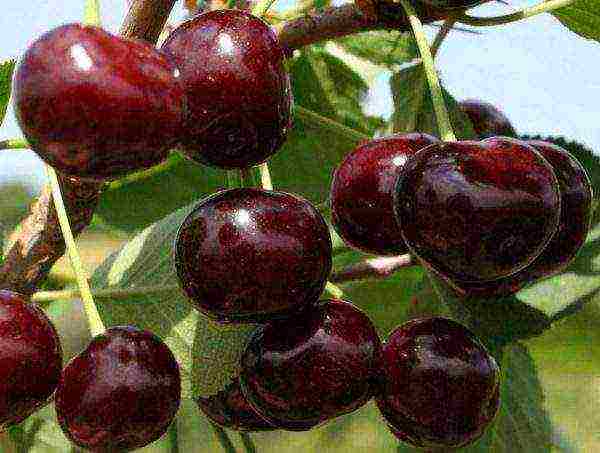 Cherry variety Zhukovskaya
Cherry variety Zhukovskaya
Cherry grows up to 2.5 meters, the crown of the tree is spreading, but rare. Leaves are narrow, oval, dark green in color. Forms inflorescences of 3-4 flowers, medium size with rounded petals. Fruiting occurs on last year's annual wood... Most often, the berries are located singly, sometimes in two. Cherry varieties Zhukovskaya medium size, up to 4 grams, dark red, heart-shaped. The pulp is tender, juicy, with a dessert taste. Disease resistance is average.
Kharitonovskaya
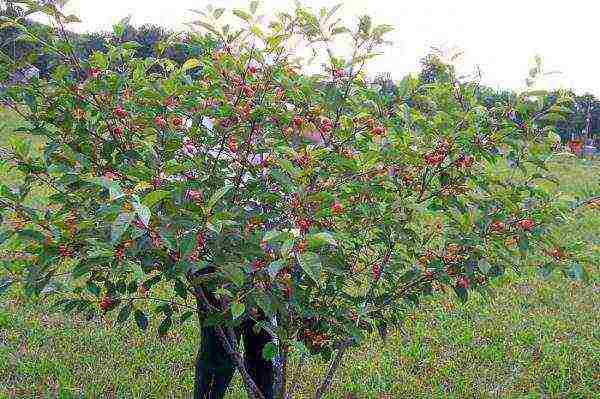 Cherry variety Kharitonovskaya
Cherry variety Kharitonovskaya
The tree grows to medium size, the flowers are large, white. The berries themselves are evenly rounded, the skin is bright red, the flesh is orange. They have a sweet and sour taste, the stone is easily separated... Good immunity to various diseases, normal frost resistance. The Kharitonovskaya variety needs additional pollination.
Turgenevka
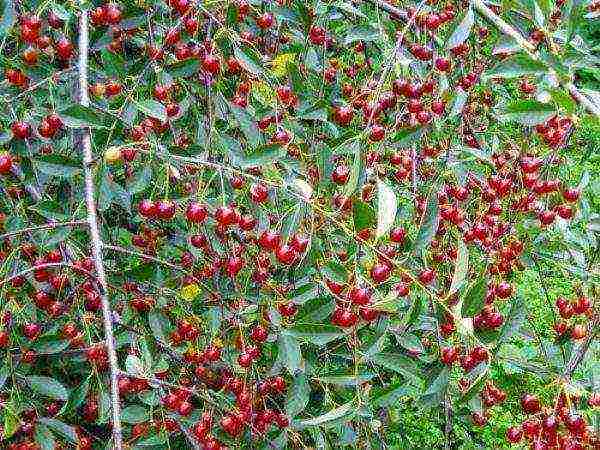 Cherry varieties Turgenevka
Cherry varieties Turgenevka
A cherry tree of this variety grows up to 3 meters, forms inflorescences of 4 white flowers. Fruiting occurs on bouquet twigs. Berries are broadly heart-shaped, large in size, weighing up to 6.5 grams... The skin color is dark red, the pulp is juicy, sour-sweet, the taste is normal. The first harvest ripens at 5-6 years of age, full ripening of fruits occurs in early July. Turgenevka tolerates winter frosts well, but may die when spring frosts appear... Possesses high resistance to diseases, requires pollinators. The variety produces a good, stable yield.
Morozovka
 Cherry with fruits grade Morozovka
Cherry with fruits grade Morozovka
The tree grows medium in size, the crown is wide, spreading. Fruiting occurs on bouquet twigs, the berries are round in shape with a fossa at the stalk, the weight can reach 5.5 grams. The skin is dark burgundy, the pulp is juicy, dessert taste with an easily detachable bone... Such berries are suitable both for fresh consumption and for processing, they are well transported. The tree begins to bear fruit at the age of 3 years, the fruit of the Morozovka variety ripens at the end of July. The yield is stable, up to 500 kilograms per hundred square meters... The variety is resistant to frost, drought and disease. Needs pollinators.
Also, the average ripening period is possessed by the varieties Radonezh, Vstrecha, Toy, Nochka.
Late varieties of cherries
Late varieties are the last to ripen, in late summer and early autumn..
Lyubskaya
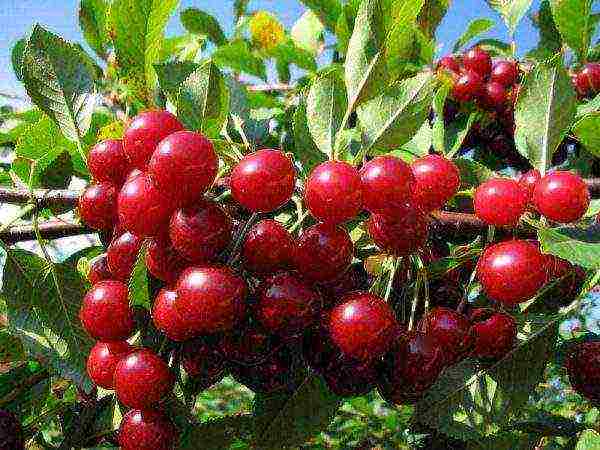 Harvest of cherries of the variety Lyubskaya
Harvest of cherries of the variety Lyubskaya
The variety is intended for cultivation in central and southern Russia, very picky about soil fertility and quality of care. Produces a large crop with blood-red, transportable fruits with a mediocre taste... These berries are ideal for processing. The tree is self-fertile, but with additional pollination it gives higher yields. A young tree bears up to 26 kilograms of fruit, and an adult up to 60. Lyubskaya does not have frost resistance, it is often exposed to various diseases.
Generous
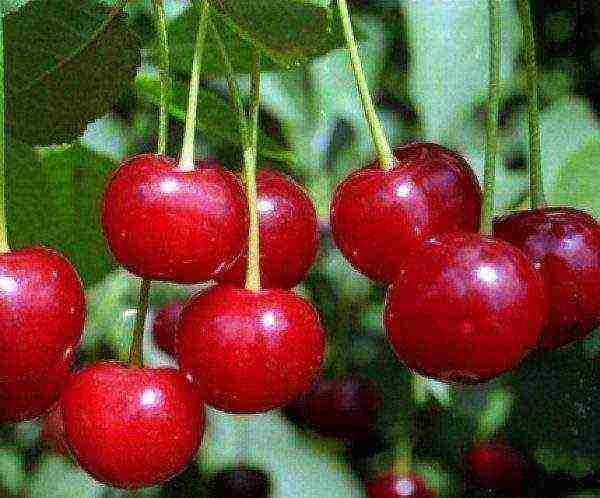 Cherry variety Generous
Cherry variety Generous
Bushy cherry with upturned shoots. The weight of one cherry is about 4 grams, its shape is round, the color is bright red. Pulp with good taste, the stone is easily separated. The presentation of the berries is at the highest level, they are resistant to cracking. Variety Generous gives an annual, bountiful harvest, ripens in autumn... The tree gives its first cherries as early as 3-4 years. Generous is distinguished by high frost resistance, can easily tolerate even spring frosts, and the variety does not lend itself to attacks by pests, and tolerates drought well. Susceptible to diseases, especially fungal diseases.
Robin
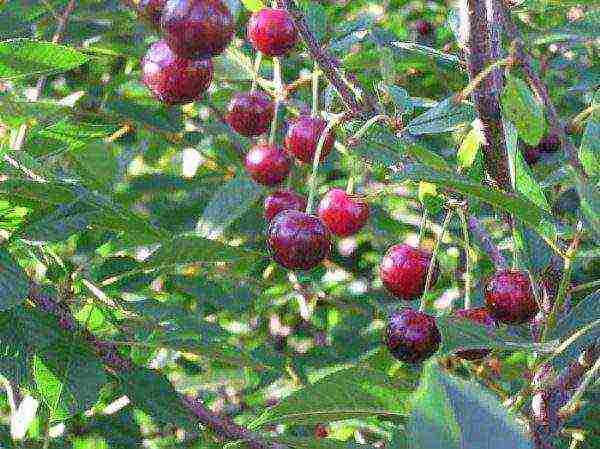 Cherry variety Malinovka
Cherry variety Malinovka
A tree of medium height with a spherical crown. Leaves with a wide plate, glossy, green, crenate edge. The cherries are small, on average, the weight of one berry is 3-3.5 grams, the shape is round... The taste is sweet and sour, pleasant, the pulp is dense. The variety gives an annual, bountiful harvest that ripens in early August. The robin needs additional pollinators and protection from disease. Frost resistance - medium.
Other varieties of late-ripening cherries are Zhuravka, Polevka, Rubinovaya, Lotovaya, Rusinka, Gorkovskaya.
Large varieties of cherries
Cherry varieties with large dessert berries are not inferior to sweet cherries in their taste. But compared to other varieties, they are whimsical to climatic conditions and quality of care.
Consumer goods Black
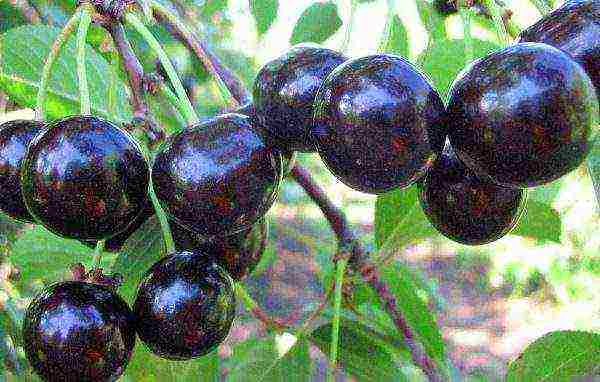 Cherry variety Consumer goods Black
Cherry variety Consumer goods Black
A low-growing tree with very tasty berries with a dark skin of almost black color. The pulp is juicy, tender, with an easily detachable bone. The fruits ripen Consumer goods Black in early June, the yield of the variety is moderate... Has a weak resistance to frost. The tree needs additional pollination.
Volochaevka
 Cherry Volochaevka
Cherry Volochaevka
A medium-sized tree is capable of producing an annual harvest. The berries are sweet, juicy with firm pulp and easily removable pits. Ripens in mid-July. The variety does not tolerate frost well, in the rainy season there is a risk of rot... Volochaevka forms both female and male flowers, self-fertile.
A meeting
 Cherry variety Meeting
Cherry variety Meeting
A low tree, the weight of the fruit of which exceeds the mark of 10 grams. The berries are bright red, with a tender and juicy pulp... The harvest of the Vetska variety is stable and annual, ripening falls on the 20th of June. The variety tolerates frost and drought well, and is resistant to fungal diseases.
Also, varieties with large fruits include Molodezhnaya, Dessertnaya Morozova, Pamyat Yenikeev, Podbelskaya, Minx, Toy, etc.
Low-growing (dwarf) cherry varieties
Trees of such varieties grow no higher than 2.5 meters.... They are very convenient for breeding and harvesting, therefore they are very popular among gardeners.
Anthracite
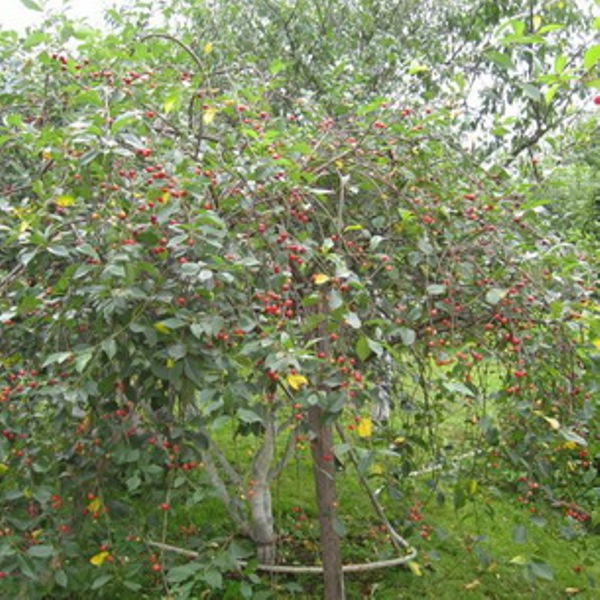 Common cherry Anthracite
Common cherry Anthracite
A bushy cherry with a wide crown, its maximum growth is 2 meters. The skin of the berries is dark, almost black in color, the pulp is blood red.... Fruit weight is 4-5 grams, taste is good. Cherries ripen in mid-summer and are well transported. The Anthracite variety is resistant to frost, drought and fungus.
Bystrinka
 Low-growing cherry variety Bystrinka
Low-growing cherry variety Bystrinka
The small tree forms a spherical crown. Burgundy berries, with the same color pulp, their weight ranges from 3.5-4.2 grams, well transported. The taste is sweet and sour. The harvest period is early July... The resistance of the Bystrinka variety to frost is average. There is a risk of damage from moniliosis.
Mtsenskaya
 Cherry grade Mtsenskaya
Cherry grade Mtsenskaya
The tree rarely exceeds 2 meters in height, the crown is oval. Average, one berry weighs 4 grams, skin color is maroon... Most often, the fruits of the Mtsenskaya variety are processed. The trees are characterized by good resistance to frost, drought and most diseases. They also have an attractive appearance, which is why they are often used in landscape design.
There are many undersized varieties of cherries, these include Lyubskaya, Molodezhnaya, Memory Mashkin, Shokoladnitsa, Vladimirskaya, Tamaris and Saratov baby.
The best cherry varieties for the southern regions of Russia
Such varieties are distinguished by excellent taste, low or medium frost resistance. Their cultivation is possible only in warm climatic conditions.
Sasha
On average, the tree grows up to 3-4 meters, the foliage is average. Fruiting occurs on annual shoots. The fruits are large, juicy, red. They are distinguished by excellent taste. The Sasha variety is frost-resistant, rarely exposed to diseases.... The first fruiting occurs in the 5th year of life, early ripening.
Garland
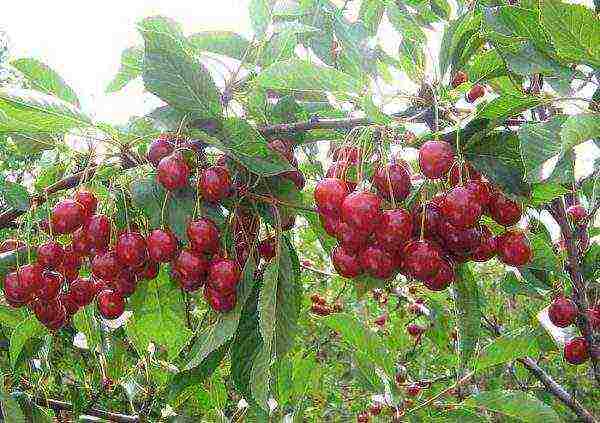 Cherry variety Garland
Cherry variety Garland
The growth of the tree is 3 meters, a large amount of foliage is formed on the branches. The Garland variety is distinguished by the presence of inflorescences, of which 5 fruits appear. The berries are very large, juicy and tasty, the skin color is slightly darker than the flesh. The first crop can be harvested in mid-June as early as the 3rd year of life... The tree does not need additional pollination.
Also, for the southern regions, varieties such as Lyubskaya, Shpanka, Shokoladnitsa are suitable.
The best cherry varieties for the northern regions
Ashinskaya
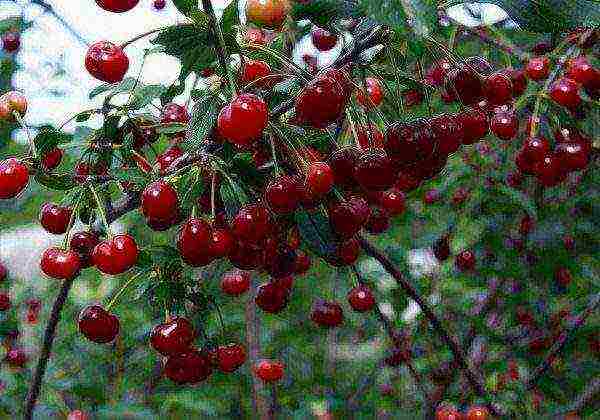 Cherry grade Ashinskaya
Cherry grade Ashinskaya
It is considered the best variety for the northern regions. A low-growing shrub, whose growth does not exceed 1.5 meters, can tolerate frosts down to -55 degrees... Also drought tolerant. Berries are dark in color, with dense pulp, slightly astringent, sweet and sour taste. The bone is small, easy to remove. Flowering occurs from the beginning of April, the shrub gives its first harvest at 4 years of age.
Ob
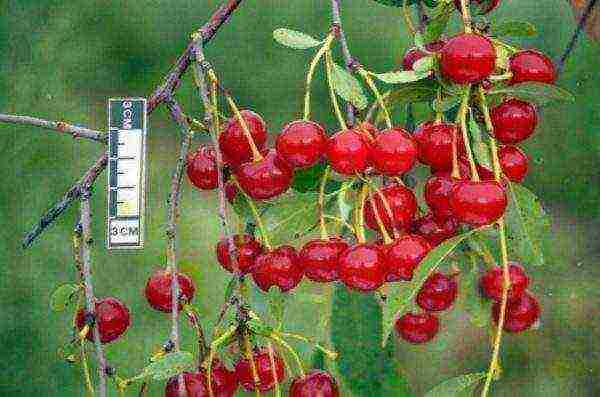 Cherry Ob
Cherry Ob
A short shrub that is only 130 centimeters tall. Fruiting occurs on annual growths. Berries are small, dark red in color, with a good taste and a small, well-separated seed... Fruits ripen in mid-July. The Ob is capable of withstanding severe frosts and drought, but is highly susceptible to pest attacks. The variety is self-fertile and does not need pollination.
Altai swallow
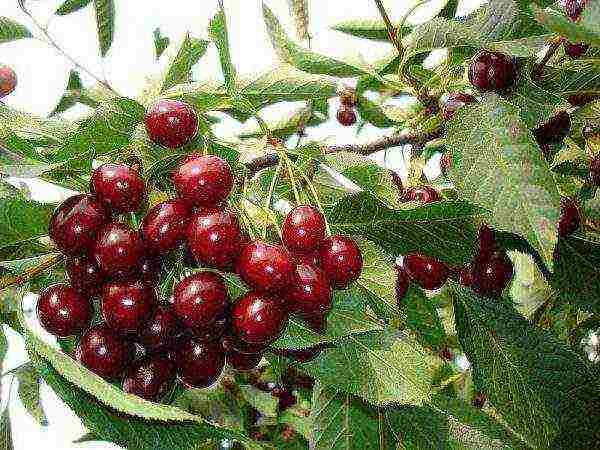 Cherry variety Altai swallow
Cherry variety Altai swallow
A low-growing bush, no more than 150 centimeters high. The berries are round in shape and medium in size, distinguished by excellent taste and juiciness... Fruit ripening occurs in mid-July. The yield of the variety is very different from the trees growing in the southern regions, and is only 5 kilograms. The Altai swallow tolerates frost and drought well, and is immune to many diseases. It is also a pollinator for many cherry varieties.
For the northern regions, the Novoaltaiskaya and Metelitsa varieties may be suitable.
The most delicious cherry varieties for Siberia and the Urals
Such varieties of cherries adapt well to the changeable climate of Siberia and the Urals, besides, they are distinguished by good yield and taste.
Ural ruby
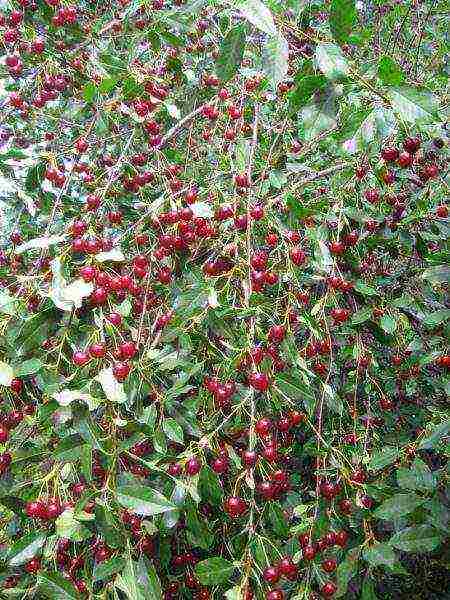 Cherry shrub Ural ruby
Cherry shrub Ural ruby
A shrub, whose growth is 1.5 meters, the crown is wide, the branches are weeping, growing downward. The leaves are wide, shiny, dark green in color, their shape resembles a boat. Fruits weigh only 3-4 grams, round in shape, dark red, juicy, sweet and sour taste... Ripen in mid-August.The variety is self-fertile, but it has a stable and good yield; an adult tree bears up to 10 kilograms of berries.
Lighthouse
 Siberian cherry variety Mayak
Siberian cherry variety Mayak
Lighthouse - a bush 2 meters high with a wide spreading crown and leaves folded into a boat. The Siberian variety is self-fertile, but when planted next to such varieties as Vole and Schedra, it gives the most abundant yields. Fruits gain weight up to 6 grams, dark red, sour-sweet taste. The crop can be harvested in early August, on average, one bush gives from 5 to 15 kilograms of fruit.
Also for these territories, the varieties Standard Ural, Schedra, Sverdlovchanka, Zagrebinskaya and Gridnevskaya are suitable.
The best cherry varieties for the Moscow region, description and care
The varieties that are best suited for the Moscow region must have good resistance to frost, and be unpretentious to the composition of the soil, a description of which can be found below.
Early varieties
From the category of early varieties of the Moscow region the varieties Molodezhnaya and Chudo cherry are best suited.
Among the mid-season varieties, one can distinguish Turgenevka, Excellent Venyaminova and Griot Moskovsky.
Griot of Moscow
 Cherry for Moscow region Griot Moskovsky
Cherry for Moscow region Griot Moskovsky
A tree with a spherical crown and matte leaves. Berries reach 3.5 grams in their weight, taste characteristics are at the highest level, fruits are suitable for various types of processing... Such a variety ripens in mid-July, the yield is above average, from a hundred square meters you can get up to a ton of cherries. Resistance to winter cold and return frost is excellent. Undergoes coccomycosis and monial burn.
Late varieties
Among the varieties of late ripening Zhukovskaya has recommended herself in the best way.
The undersized (dwarf) cherry varieties for the Moscow region include Molodezhnaya, Mayak, Tamaris, Bystrinka, Memory Mashkin and Malyshka.
Tamaris
The crown of the tree is small, rounded. Fruits are dark red in color with sparse brown spots. The pulp of the berries is juicy, the taste is sour. Cherries can be used both for fresh consumption and for various processing, the transportability of the fruits is average. You can harvest the crop in early August. The variety has good frost and drought resistance.
In memory of Mashkin
 Cherry variety in Memory of Mashkin
Cherry variety in Memory of Mashkin
The crown of the tree is spreading, drooping, spherical in shape. The fruits are large in size, grow up to 5 grams, with their own dessert taste, they often become an adornment of any garden. Maturation occurs in mid-July... Resistance to frost and sore immunity is average.
Self-fertile varieties
The most popular self-fertile varieties for the Moscow region are Apukhtinskaya, Lyubskaya, Zagorievskaya, Volochaevka, Shokoladnitsa, Vstrecha, Garland and Cinderella.
Cinderella
Medium-sized tree, forming fruits weighing 4 grams, rounded oval and light red in color, sweet and sour taste. The harvest ripens in mid-July, from one tree you can get up to 15 kilograms of berries... The frost resistance of the tree itself and of the flower buds is excellent. The variety does not require additional protection against fungal diseases.
Breeders have bred a huge number of cherry varieties, which makes it possible to grow this crop in all corners of Russia. For the most part, all trees have good to medium frost resistance and bear sweet and sour fruits.... Each gardener can choose and plant the cherry that will decorate his particular plot.
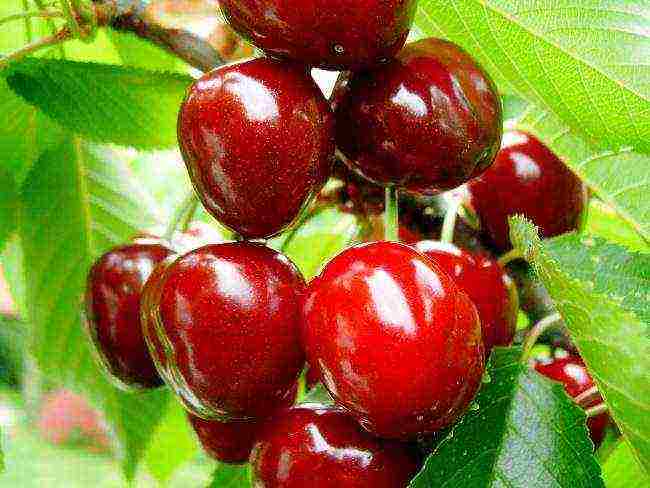 The best varieties of cherries
The best varieties of cherries
Hello dear readers! I just re-read the article on the best varieties of strawberries, and I thought, why not write similar information about cherries.
The best varieties of cherries are quite picky, so in order to get a good harvest, you need to be able to care for the plant, to know its biological characteristics.
Cherry is a perennial woody plant. But, there are also cherries that grow in the form of a bush.Woody forms reach heights of up to five meters, bush - up to two and a half. Bushes can be formed with two to three trunks, more is not desirable.
The best varieties of cherries do not form fruits from fertilization with their pollen, no matter how well they bloom. In order for the fruits to form, the flowers must be pollinated with pollen of another variety, which are called pollinator varieties.
The best cherry varieties bear fruit depending on where they grow. Therefore, the place must be chosen correctly. In one place, the plant bears fruit for fifteen to sixteen years, therefore, mistakes made when choosing a territory will greatly affect the yield.
The best varieties of cherries have lower winter hardiness than gooseberries or currants. She loves places with good lighting, but can also bear fruit in the shade. Whenever possible, it is worth choosing well-lit places protected from the winds. Cherry prefers to grow on sandy loam soils with a neutral reaction of the environment. Groundwater should be no higher than one and a half meters.
The following are the best varieties of cherries:
- cherry "Molodezhnaya";
- cherry "Turgenevka";
- Cherry "Shokoladnitsa";
- Cherry "Lyubskaya".
Cherry "Youth"
 Cherry "Youth"
Cherry "Youth"
Cherry "Youth" was obtained by crossing the varieties "Vladimirskaya" and "Lyubskaya".
Trees reach heights of up to two and a half meters, the crown is rounded, somewhat drooping. Leaves are medium in size, bright green, crenate edges. Cherry "Youth" bears fruit on bouquet branches and growths of the last year.
Fruits are large in size, about four and a half grams, dark maroon. They can be eaten fresh or processed (make jams, preserves, compotes). The taste of berries is sweet and sour, belongs to dessert, the pulp is dense, very juicy.
The juice has a dark red color, the stone is medium in size, it is easy to separate it from the pulp. The productivity of the variety is quite high - ten to twelve kilograms per tree or ten tons per hectare. The variety is fast-growing, bears fruit annually. Winter hardiness is high enough. In addition, Molodezhnaya cherries are moderately susceptible to fungal diseases.
Among the advantages of the variety, the following can be noted:
- average ripening period;
- high productivity.
Cherry "Turgenevka"
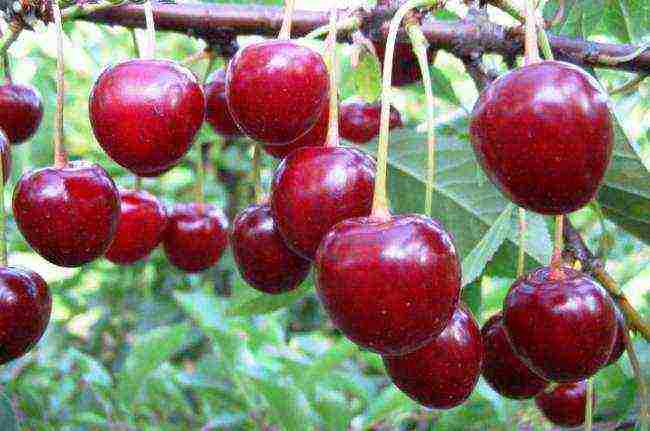 Cherry "Turgenevka"
Cherry "Turgenevka"
Cherry "Turgenevka" was obtained from seedlings from free pollination of the Zhukovskaya variety.
The height of the tree is about three meters, with a reverse pyramidal crown of medium density. Shoots are straight, medium, brown. The bark is grayish brown. Buds are cone-shaped, deflected from the shoot. Narrow oval leaf, dark green. The apex is strongly tapered, the base is sharp. The leaf blade is shiny. The petiole is about twenty-one millimeters long with an anthocyanin coloration. There are four flowers in the inflorescence. The petals are white. The cup is shaped like a glass.
The mass of the fruit is five grams, broad-mouthed, about twenty millimeters wide, twenty millimeters high. The berries are dark red, the flesh is the same, dense and juicy. The peduncle is fifty-one centimeters long. The stone weighs 0, 4 grams, oval, cream color. The base of the stone is rounded, the apex is pointed. It separates well from the pulp.
Cherry "Turgenevka" has sweet and sour fruits. The separation from the stem is average. Fruits contain more than eleven percent sugar.
Blossoms in mid-May, fruits ripen in July. Begins to bear fruit in the fifth year of life. Winter hardiness is high. Average resistance to moniliosis and coccomycosis.
The advantages of the variety are:
- productivity;
- winter hardiness;
- high quality fruits.
Disadvantage: the winter hardiness of flower buds is insufficient.
Cherry "Shokoladnitsa"
 Cherry "Shokoladnitsa"
Cherry "Shokoladnitsa"
Cherry "Shokoladnitsa" - a tree that reaches up to two and a half meters in height. The crown is of medium density, the crown is reverse pyramidal.Shoots are straight, medium, brown. On the main branches, the bark is brown. Bud cone-shaped, closely pressed to the shoot, four millimeters long. The leaf is green, obovate, the apex and base are pointed. The surface of the plate is matte.
Cherry "Shokoladnitsa" has a petiole sixteen millimeters long, about two millimeters thick. There are three flowers in the inflorescence. The petals are white, they are located freely. The pistil is five millimeters long, the stamens are about seven millimeters long.
Fruit weight is three and a half grams, height and thickness are seventeen millimeters. The funnel is medium. The fruits are almost black in color. The pulp is dark red, medium density, the juice is the same color. The stalk is thirty-six centimeters long. The stone is yellow, makes up eight percent of the fruit weight. The fruit contains more than twelve percent of sugars.
Cherry "Shokoladnitsa" blooms in May, the fruits ripen in July. Begins to bear fruit in the fourth year. The wood and buds withstand frost and drought well. The variety is susceptible to diseases of moniliosis and coccomycosis.
The advantages of the variety are:
- high productivity;
- winter hardiness;
- self-fertility.
The disadvantage is susceptibility to moniliosis and coccomycosis.
Cherry "Lyubskaya"
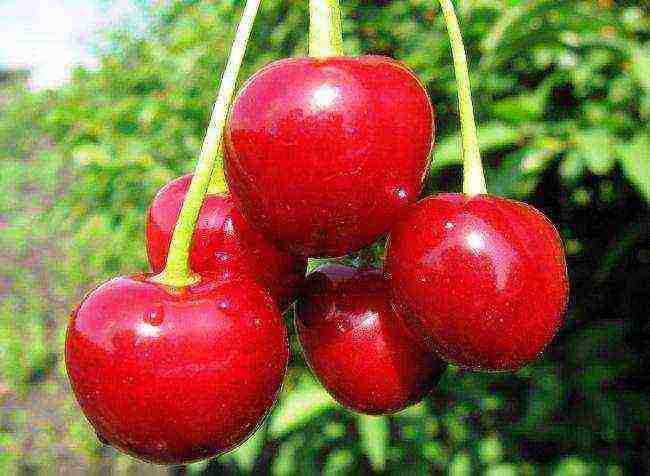 Cherry "Lyubskaya"
Cherry "Lyubskaya"
Cherry "Lyubskaya" reaches up to two and a half meters in height with a sparse, broadly spreading crown. The bark is brown-gray, the bark is cracked, the branches are curved. Branches are brown, drooping. Vegetative buds are rounded, slightly deviate from the shoot, generative buds are oval.
Leaves are slightly shiny, dense, dark green, obovate. There are three to four flowers in the inflorescence, their diameter is thirty to thirty four millimeters. The petals are concave, rounded, their base is elongated, the apex is rounded. The calyx is goblet, greenish.
Cherry "Lyubskaya" by the nature of fruiting, it belongs to bush cherries and bears fruit on annual branches.
Fruit weight up to four grams or more, dark red with red juice, rounded apex, somewhat dull, wide funnel. The pulp is juicy and tender, dark red, sweet and sour taste, contains many useful substances, including vitamin C.
The seed weighs 0.3 grams and makes up eight percent of the fruit. The length of the stalk is from thirty-five millimeters, the fruits do not crumble.
Cherry "Lyubskaya" has a mediocre taste, so it is used to make compotes, wine and jam, frozen and dried.
They begin to bear fruit early, two to three years after planting, productivity is increased very early.
The duration of flowering depends on weather conditions and lasts five to eight days. The fruits do not fall off.
Cherry "Lyubskaya" has good productivity, up to twenty-five kilograms can be harvested from a tree.
Average frost resistance, most often skeletal branches and staffs freeze. The plant lives up to twenty-five years.
Cherry "Lyubskaya" - a valuable industrial variety, although not suitable for cultivation in northern latitudes. The variety is picky about the soils on which it grows, and loves care. The plant is especially favorable to mineral and organic fertilizers.
Cherry "Lyubskaya" is prone to the formation of kidney mutations, which differ in productivity, ripening time, fruit quality and size:
- Lyubskaya fruitful;
- Late Lyubskaya;
- Lyubskaya bouquet and others.
The advantages of the variety are:
- high level of potential productivity;
- good presentation of berries;
- good transportability.
The disadvantages of the variety are:
- tendency to fungal diseases;
- insufficient frost resistance;
- increased acidity of fruits.
Thus, we see that all the best cherry varieties have a wide variety of characteristics, they have their own advantages and benefits, but be that as it may, with proper care, you can get an excellent harvest.
Pavlenko Tatiana, member of the editorial board Sobcor of the independent Internet publication ATMAgro. Agroindustrial Bulletin "
The cherry tree is one of the most popular three fruit crops in Russia and Ukraine. The fruits are distinguished by excellent taste and nutritional qualities. They are healthy, aromatic, juicy and tasty. The tree is not whimsical to care for, so a novice gardener can grow it. Currently, there are a huge number of varieties, so making a choice between them is very problematic. On the basis of ordinary cherries, breeders have bred about 140 different varieties. Each of them has certain advantages and disadvantages, differs in the rules of planting, care, which are important to know in order to get a generous harvest.
Main characteristics of varieties
All cherry varieties are divided into 2 large groups:
- Amoreli are light fruits with clear juice.
- Moreli - dark berries with colored juice.
Before making a choice, you need to pay attention to the following aspects:
- tree height;
- stability, crop size;
- ripening terms;
- the need for sunlight;
- the presence of resistance to droughts, frosts, diseases.
All cherry varieties are subdivided according to some traits. Characteristics of subgroups:
A variety of fruiting, growth
- intermediate;
- bushy;
- tree-like.
Bush cherry is a small tree or bush, the height of which ranges from 2-3 meters. It is important to remember that such varieties of cherries form fruit on last year's young shoots. The name of the bushy representatives of the fruit plant:
- Generous;
- Youth;
- Crimson and Lyubskaya;
- Ideal, Fertile, Michurina.
As for the tree type, the height of an adult tree varies within 2.5-6 meters. Interestingly, these cherry varieties are quite durable. The fruits are concentrated on bouquet branches, the length of which is 3-5 cm.This group includes the following species:
- Zhukovskaya;
- Consumer goods Black;
- Early Orlovskaya;
- Flask Pink and Rustunya.
On intermediate cherry plants, the arrangement of berries focuses on one-year-old last year's increments, bouquet branches. Variety names:
- Bystrinka;
- Muse.
Berry ripening time: early, medium, late
As for the early fruits, ripening occurs at the end of June-beginning of July. Late varieties - late July and early August. The ripening period is indicated in the descriptions of each cherry variety. The early ones include:
- Flask Pink;
- Minx;
- Kent.
Medium types include the following:
- Lada;
- Ryazanochka and the Torch;
- Vladimirskaya.
As for the late varieties, the main representatives are:
- Toy;
- Lyubskaya;
- Erudite and Tamaris.
Fruiting methods
- self-fertile;
- self-infertile.
Cross-pollination is required for a good harvest. In simple words, pollinating varieties should be planted next to the tree so that insects can transfer pollen to the pistils of flowers.
Self-fertile trees are able to pollinate themselves on their own, since the anther with pollen is located at the same level with the pistils. Self-fertile cherries tie 20-40% of all flowers. These include:
- Chocolate girl;
- Sudarushka;
- Anadolskaya and Lada;
- Unbraid, Nord Star.
Representatives of self-fertile cherry trees, shrubs:
- Elegy;
- Robin;
- Loyalty and Griot of Moscow;
- Black is large.
For each self-fertile variety, the best pollinator is designed.
Unpretentious and common varieties
The main qualities of fruit crops are frost resistance and easy care. If the plant grows far away in the country, it will be difficult for the gardener to pay maximum attention to this tree. Therefore, it is important to choose cherry varieties that do not need constant, painstaking care. The most persistent are the following varieties of cherry trees: Shpanka large, Vladimirskaya, Toy, Turgenevka and Morozovka.
Shpanka is large, unpretentious, hardy.It was bred in Ukraine about a hundred years ago, where it gained extraordinary popularity. The tree is tall, fruiting is observed from the fifth year after planting in the ground. Provides the grower with an abundant, regular and annual harvest. The fruits are of medium size, clear juice. Taste - there is a slight sour note. It belongs to the self-fertile type, but for a bountiful harvest, you will need a pollinator - a sweet cherry, another cherry. Feels great at a temperature of 35 degrees below zero. If you do not fertilize, Shpanka will hurt.
A variety such as Toy represents tall varieties of a fruit plant. The name comes from the size of the fruit. The mass of one berry is equal to eight grams, which is considered a great rarity. The palatability received an assessment of 4.5 points. Delicious juice and wine are obtained from the fruits. Fruiting begins in the third year of life. There is resistance to diseases, droughts. As for winter hardiness, it is much lower than that of other representatives of this group.
Large and delicious fruits
If a gardener can devote a certain amount of time to his garden, it is better for him to plant varieties of cherries that are distinguished by excellent dessert, large fruits. Basically, they are characterized by late ripening, they are very capricious, they require ideal conditions.
The best varieties of the presented group are recognized:
- Zhukovskaya;
- Volochaevka;
- Consumer goods Black;
- A meeting.
As for Volochaevka, the trees are not too tall. They are characterized by high productivity, and ripening occurs in the second decade of July. The fruits are very fragrant, juicy, there is a slight separation of the bone from the pulp. According to the tasters, the berries were rated 4.8 points. Fruiting is regular, stable in the absence of severe frosts. Resistance to mycoses is noted, however, in the case of a rainy summer, a defeat by coccomycosis is observed. The main advantage is self-fertility.
Cherry variety Vstrecha is characterized by very massive berries weighing more than ten grams. The color is deep red. A distinctive feature is tender and juicy pulp, excellent taste, which received a mark of 5 out of 5. There is partial self-fertility, resistance to frost, mycoses. In demand among gardeners.
The best representatives of bush varieties
Gardeners pay particular attention to the height of mature trees. As for compact bush plants, they have many advantages. They do not take up much space on the land; they are characterized by simple care and harvesting.
The most successful varieties include the following:
- Baby;
- Youth;
- Tamaris;
- Anracite.
The Tamaris variety is represented by a shrub that gives an unusually generous harvest. There are a lot of fruits on the branches, so they need to be cut off periodically. The color of the berries is purple. The taste is juicy. Excellent resistance to frost and mycoses is noted.
As for such a species as Malyshka, the harvest begins to ripen at the end of June. Fruit color is dark red. Differs in a presentable appearance, received an assessment of 5 points in this parameter. High frost resistance.
Youth cherry reaches 2 meters in height, has a drooping crown. The branches are easy to harvest. The fruits are versatile, ripen at the end of July. The color of the berries is burgundy, the flesh is quite dense, the stone comes off easily. It is self-fertile, has good resistance to fungi and frost.
All cherry varieties have their pros and cons. Before making a choice, it is important to carefully study all the features of the varieties and choose the most suitable for the terrain and weather conditions.
